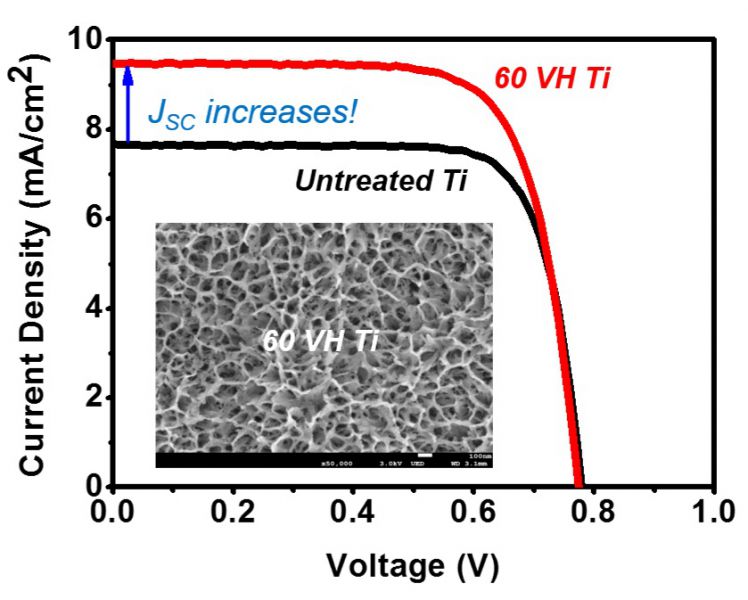設施農業:節能栽培與滅菌【化學工程學系/陳志銘特聘教授】
| 論文篇名 | 英文:Increasing Solar Light Efficiency by Engineering Cell Structures with Modified Ti Foil and Specific Concentrations of Electrolyte in Liquid Dye-Sensitized Solar Cells 中文:透過結構工程修飾鈦基板並搭配特定電解液濃度提升液態染料敏化太陽能電池之光電效率 |
| 期刊名稱 | ELECTROCHIMICA ACTA |
| 發表年份,卷數,起迄頁數 | 2020, 334, 135631 |
| 作者 | Chen, Yu-Wen; Sil, Manik Chandra; Chen, Chih-Ming(陳志銘)* |
| DOI | 10.1016/j.electacta.2020.135631 |
| 中文摘要 | 在鎢、鋅、鈷、鎳、鉑、鋁和銅這幾種d區元素中,鈦由於高的機械強度及柔韌性,並且對電解質具有良好的耐腐蝕性,使其在染料敏化太陽能電池中作為光陽極受到了越來越多的關注。通過使用陽極氧化技術在鈦板上施加不同的電壓從而改變鈦板的厚度、顏色和表面結構以改善電荷轉移和電子注入的效率。在本研究中,通過使用陽極氧化技術處理鈦板並使用雙氧水蝕刻,研究太陽能電池效率的變化。研究結果表明,太陽能電池效率的提高可歸因於鈦片經陽極氧化處理和過氧化氫蝕刻後,在表面產生的奈米多孔的結構所致。進一步的研究則是使用N719染料並在不同的光照下改變電解液的濃度以提高太陽能電池的效率。施加60 V電勢差的陽極氧化處理,使用改質的鈦箔和0.00625 M的碘電解液,在一個日光照射下觀察到電池最大轉換效率為5.27%(其中JSC為9.501 mA / cm2,VOC為0.750 V,FF為0.741)。 |
| 英文摘要 | Out of several d-block elements, such as tungsten, zinc, cobalt, nickel, platinum, aluminum, and copper, titanium (Ti) has received more attention as a photoanode in dye-sensitized solar cells due to its high mechanical strength, flexibility, and good corrosion resistance towards common electrolytes. Charge transfer and electron injection efficiency can be modified by using anodizing oxidation technology (AOT) and applying different voltages on a Ti sheet, which modifies the thickness, color and surface structure of the Ti sheet. In this study, the variation in solar power efficiency was investigated by manufacturing solar devices with Ti sheets modified by AOT treatment followed by H2O2 etching. The investigated results show that the improved efficiency of the solar cell could be attributed to the robust and nanoporous structure of the surface layer on the Ti sheet, which was created by sequential AOT treatment and peroxide etching. Further studies have been performed to increase the efficiency of solar cells using N719 dye and changing the concentration of electrolyte under different light illumination. The maximum power conversion efficiency of 5.27% (JSC of 9.501 mA/cm2, VOC of 0.750 V with 0.741 FF) was observed using modified Ti foil and 0.00625 M iodine by applying a 60 V potential difference under 1 sun illumination. |







